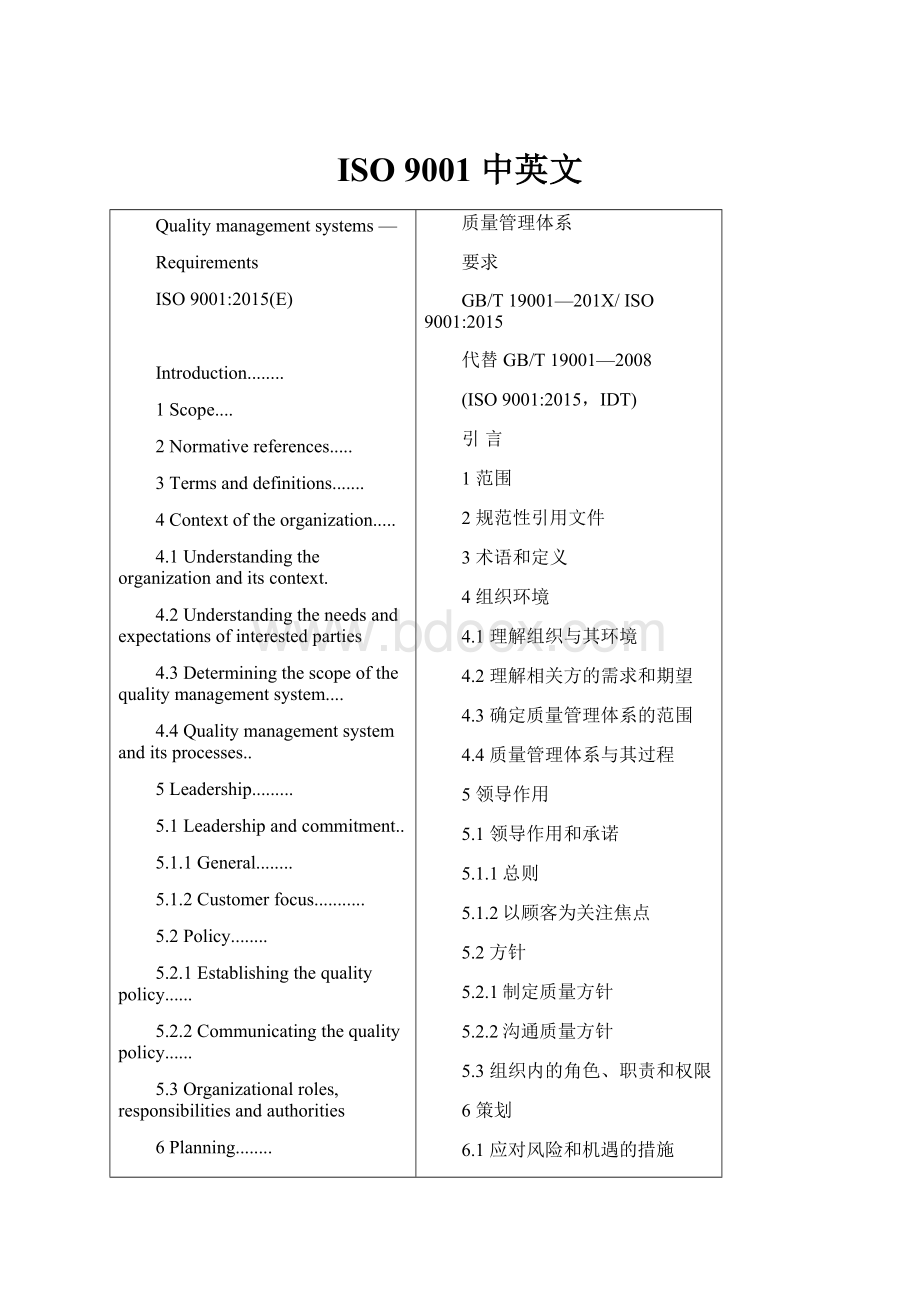ISO 9001 中英文.docx
《ISO 9001 中英文.docx》由会员分享,可在线阅读,更多相关《ISO 9001 中英文.docx(64页珍藏版)》请在冰豆网上搜索。

ISO9001中英文
Qualitymanagementsystems—
Requirements
ISO9001:
2015(E)
Introduction........
1Scope....
2Normativereferences.....
3Termsanddefinitions.......
4Contextoftheorganization.....
4.1Understandingtheorganizationanditscontext.
4.2Understandingtheneedsandexpectationsofinterestedparties
4.3Determiningthescopeofthequalitymanagementsystem....
4.4Qualitymanagementsystemanditsprocesses..
5Leadership.........
5.1Leadershipandcommitment..
5.1.1General........
5.1.2Customerfocus...........
5.2Policy........
5.2.1Establishingthequalitypolicy......
5.2.2Communicatingthequalitypolicy......
5.3Organizationalroles,responsibilitiesandauthorities
6Planning........
6.1Actionstoaddressrisksandopportunities........
6.2Qualityobjectivesandplanningtoachievethem..
6.3Planningofchanges...........
7Support............
7.1Resources....
7.1.1General....
7.1.2People...
7.1.3Infrastructure.......
7.1.4Environmentfortheoperationofprocesses.
7.1.5Monitoringandmeasuringresources..
7.1.6Organizationalknowledge......
7.2Competence....
7.3Awareness...
7.4Communication.....
7.5Documentedinformation.............
7.5.1General......
7.5.2Creatingandupdating...........
7.5.3Controlofdocumentedinformation
8Operation.....
8.1Operationalplanningandcontrol...........
8.2Requirementsforproductsandservices....
8.2.1Customercommunication.....
8.2.2Determiningtherequirementsforproductsandservices....
8.2.3Reviewoftherequirementsforproductsandservices..
8.2.4Changestorequirementsforproductsandservices......
8.3Designanddevelopmentofproductsandservices....
8.3.1General......
8.3.2Designanddevelopmentplanning...
8.3.3Designanddevelopmentinputs....
8.3.4Designanddevelopmentcontrols.......
8.3.5Designanddevelopmentoutputs........
8.3.6Designanddevelopmentchanges....
8.4Controlofexternallyprovidedprocesses,productsandservices..
8.4.1General......
8.4.2Typeandextentofcontrol.......
8.4.3Informationforexternalproviders.............
8.5Productionandserviceprovision.....
8.5.1Controlofproductionandserviceprovision...
8.5.2Identificationandtraceability.......
8.5.3Propertybelongingtocustomersorexternalproviders
8.5.4Preservation......
8.5.5Post-deliveryactivities........
8.5.6Controlofchanges..................
8.6Releaseofproductsandservices...
8.7Controlofnonconformingoutputs......
9Performanceevaluation....
9.1Monitoring,measurement,analysisandevaluation....
9.1.1General..
9.1.2Customersatisfaction..
9.1.3Analysisandevaluation.....
9.2Internalaudit.......
9.3Managementreview..
9.3.1General......
9.3.2Managementreviewinputs.
9.3.3Managementreviewoutputs......
10Improvement.......
10.1General........
10.2Nonconformityandcorrectiveaction.....
10.3Continualimprovement.....
AnnexA(informative)Clarificationofnewstructure,terminologyandconcepts..
AnnexB(informative)OtherInternationalStandardsonqualitymanagementandqualitymanagementsystemsdevelopedbyISO/TC176..
Bibliography.....
Introduction
0.1General
Theadoptionofaqualitymanagementsystemisastrategicdecisionforanorganizationthatcanhelptoimproveitsoverallperformanceandprovideasoundbasisforsustainabledevelopmentinitiatives.
ThepotentialbenefitstoanorganizationofimplementingaqualitymanagementsystembasedonthisInternationalStandardare:
a)theabilitytoconsistentlyprovideproductsandservicesthatmeetcustomerandapplicablestatutoryandregulatoryrequirements;
b)facilitatingopportunitiestoenhancecustomersatisfaction;
c)addressingrisksandopportunitiesassociatedwithitscontextandobjectives;
d)theabilitytodemonstrateconformitytospecifiedqualitymanagementsystemrequirements.
ThisInternationalStandardcanbeusedbyinternalandexternalparties.
ItisnottheintentofthisInternationalStandardtoimplytheneedfor:
—uniformityinthestructureofdifferentqualitymanagementsystems;
—alignmentofdocumentationtotheclausestructureofthisInternationalStandard;
—theuseofthespecificterminologyofthisInternationalStandardwithintheorganization.
ThequalitymanagementsystemrequirementsspecifiedinthisInternationalStandardarecomplementarytorequirementsforproductsandservices.
ThisInternationalStandardemploystheprocessapproach,whichincorporatesthePlan-Do-Check-Act(PDCA)cycleandrisk-basedthinking.
Theprocessapproachenablesanorganizationtoplanitsprocessesandtheirinteractions.
ThePDCAcycleenablesanorganizationtoensurethatitsprocessesareadequatelyresourcedandmanaged,andthatopportunitiesforimprovementaredeterminedandactedon.
Risk-basedthinkingenablesanorganizationtodeterminethefactorsthatcouldcauseitsprocessesanditsqualitymanagementsystemtodeviatefromtheplannedresults,toputinplacepreventivecontrolstominimizenegativeeffectsandtomakemaximumuseofopportunitiesastheyarise(seeClauseA.4).
Consistentlymeetingrequirementsandaddressingfutureneedsandexpectationsposesachallengefororganizationsinanincreasinglydynamicandcomplexenvironment.Toachievethisobjective,theorganizationmightfinditnecessarytoadoptvariousformsofimprovementinadditiontocorrectionandcontinualimprovement,suchasbreakthroughchange,innovationandre-organization.
InthisInternationalStandard,thefollowingverbalformsareused:
—“shall”indicatesarequirement;
—“should”indicatesarecommendation;
—“may”indicatesapermission;
—“can”indicatesapossibilityoracapability.
Informationmarkedas“NOTE”isforguidanceinunderstandingorclarifyingtheassociatedrequirement.
0.2Qualitymanagementprinciples
ThisInternationalStandardisbasedonthequalitymanagementprinciplesdescribedinISO9000.Thedescriptionsincludeastatementofeachprinciple,arationaleofwhytheprincipleisimportantfortheorganization,someexamplesofbenefitsassociatedwiththeprincipleandexamplesoftypicalactionstoimprovetheorganization’sperformancewhenapplyingtheprinciple.
Thequalitymanagementprinciplesare:
—customerfocus;
—leadership;
—engagementofpeople;
—processapproach;
—improvement;
—evidence-baseddecisionmaking;
—relationshipmanagement.
0.3Processapproach
0.3.1General
ThisInternationalStandardpromotestheadoptionofaprocessapproachwhendeveloping,implementingandimprovingtheeffectivenessofaqualitymanagementsystem,toenhancecustomersatisfactionbymeetingcustomerrequirements.Specificrequirementsconsideredessentialtotheadoptionofaprocessapproachareincludedin4.4.
Understandingandmanaginginterrelatedprocessesasasystemcontributestotheorganization’seffectivenessandefficiencyinachievingitsintendedresults.Thisapproachenablestheorganizationtocontroltheinterrelationshipsandinterdependenciesamongtheprocessesofthesystem,sothattheoverallperformanceoftheorganizationcanbeenhanced.
Theprocessapproachinvolvesthesystematicdefinitionandmanagementofprocesses,andtheirinteractions,soastoachievetheintendedresultsinaccordancewiththequalitypolicyandstrategicdirectionoftheorganization.ManagementoftheprocessesandthesystemasawholecanbeachievedusingthePDCAcycle(see0.3.2)withanoverallfocusonrisk-basedthinking(see0.3.3)aimedattakingadvantageofopportunitiesandpreventingundesirableresults.
Theapplicationoftheprocessapproachinaqualitymanagementsystemenables:
a)understandingandconsistencyinmeetingrequirements;
b)theconsiderationofprocessesintermsofaddedvalue;
c)theachievementofeffectiveprocessperformance;
d)improvementofprocessesbasedonevaluationofdataandinformation.
Figure1givesaschematicrepresentationofanyprocessandshowstheinteractionofitselements.Themonitoringandmeasuringcheckpoints,whicharenecessaryforcontrol,arespecifictoeachprocessandwillvarydependingontherelatedrisks.
Figure1—Schematicrepresentationoftheelementsofasingleprocess
0.3.2Plan-Do-Check-Actcycle
ThePDCAcyclecanbeappliedtoallprocessesandtothequalitymanagementsystemasawhole.Figure2illustrateshowClauses4to10canbegroupedinrelationtothePDCAcycle.
NOTENumbersinbracketsrefertotheclausesinthisInternationalStandard.
Figure2—RepresentationofthestructureofthisInternationalStandardinthePDCAcycle
ThePDCAcyclecanbebrieflydescribedasfollows:
—Plan:
establishtheobjectivesofthesystemanditsprocesses,andtheresourcesneededtodeliverresultsinaccordancewithcustomers’requirementsandtheorganization’spolicies,andidentifyandaddressrisksandopportunities;
—Do:
implementwhatwasplanned;
—Check:
monitorand(whereapplicable)measureprocessesandtheresultingproductsandservicesagainstpolicies,objectives,requirementsandplannedactivities,andreporttheresults;
—Act:
takeactionstoimproveperformance,asnecessary.
0.3.3Risk-basedthinking
Risk-basedthinking(seeClauseA.4)isessentialforachievinganeffectivequalitymanagementsystem.Theconceptofrisk-basedthinkinghasbeenimplicitinpreviouseditionsofthisInternationalStandardincluding,forexample,carryingoutpreventiveactiontoeliminatepotentialnonconformities,analyzinganynonconformitiesthatdooccur,andtakingactiontopreventrecurrencethatisappropriatefortheeffectsofthenonconformity.
ToconformtotherequirementsofthisInternationalStandard,anorganizationneedstoplanandimplementactionstoad